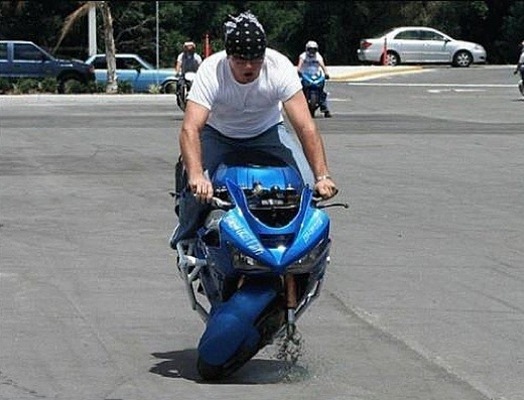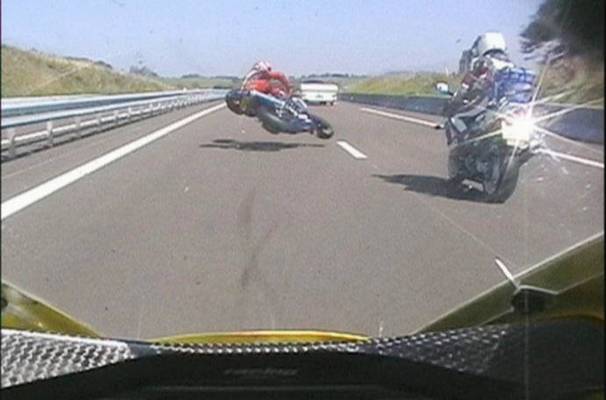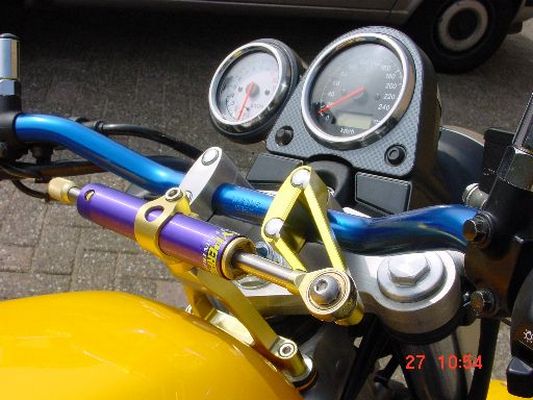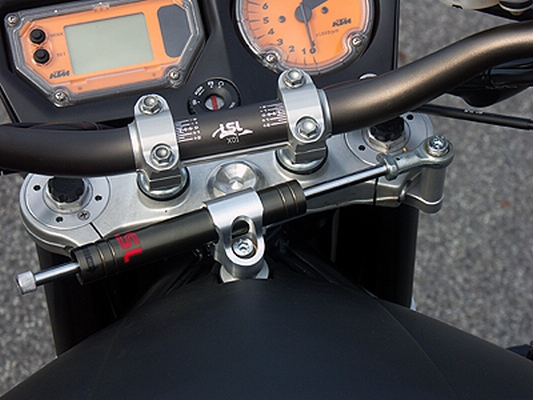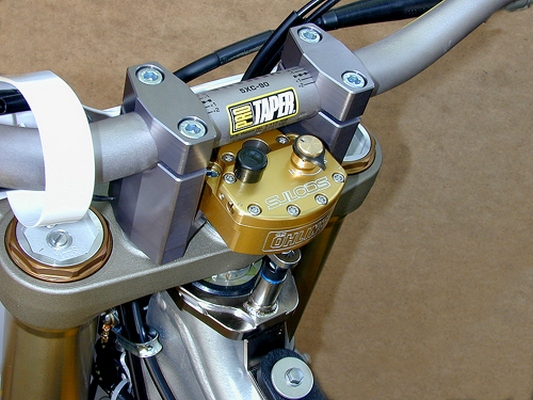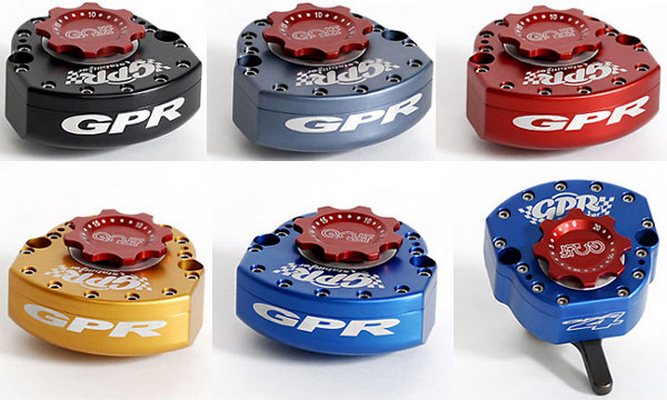Wobbling is a phenomenon which will cross the path of almost any motorcycle rider sooner or later. Despite being one of the rather important causes for crashes, the wobbling effect can be overcome and there are a lot of examples of guys making it safely through such peril.
What is wobbling?
Wobbling could be generally defined as side-to-side movement of a wheel. Note that wobbling can occur at the front wheel, as it can also be present at the rear wheel of a bike. With the rear wheel wobble being easier to control, a wobbly front wheel can crash a bike in no time.
Wobbling can be caused by a lot o factors, among which the most likely to met one is failing to properly align the front wheel when landing a wheelie. The Internet is literally full of videos showing guys spilling in the most interesting, funny or horrible ways after improperly landing a wheelie.
At the same time, violent accelerations might cause the front wheel to wobble due to the lesser pressure of the wheel pushing the ground. Wobbling may also be caused by improperly loading your bike, defective wheel alignment, lower tire pressure or faulty rims.
If you've gotten to the point where you feel that are not in full control of the bike and handlebars, it's best to pull over and make a quick visual inspection of the bike, checking for a deflated tire, bent components, even loose bolts and so on. It's advisable to have a mechanic checking the bike, and in case you have to drive on, do so at a low speed.
It's true: the rear wheel wobble can even pass unnoticed in case of heavier bikes or heavy riders, despite the fact that those riding behind you will definitely see the abnormal dynamics of the rear wheel. At low speed and especially with a heavy load on the bike, the rear wobble is harder to detect, but just like in other case, pulling over and taking a look at the bike is critical.
All in all, there is no need form drama, so far. Your bike may wobble because one or both tires have lower pressure. The lesser the air force opposing the weight of the bike, the more will the tire wall bend, especially when turning. This bending will send vibrations through the entire bike and is almost impossible to miss.
He whole motorcycle feels a bit flabby, and control over a smooth round trace is harder to obtain. As the tire flexes uncontrollably, the bike will shake accordingly, sometimes giving unsuspecting riders quite a good scare.
Like in any critical scenario, not losing your mind is a good thing: slow down progressively and inflating the tires to their normal pressure should rid you of the wobbles. Please note that running lower pressure in the tires for longer periods of time will cause them to wear out in a different manner, with a negative impact on handling in turns.
Now, the greater the speed, the bigger the number of dangerous things which could meddle with a nice afternoon ride. High-speed wobbling is the most dangerous since the forces shaking the bike or handlebars are much harder to counteract.
As we've mentioned above, improper alignment of the front wheel with the direction the rear one is facing will surely cause the bike to wobble violently. The force is so strong that the handlebar can oscillate almost fully to the right or left, and in this case a crash is imminent.
Even with lower oscillation angles, such string wobbling makes the rider lose control of the bike and could possibly send him/ her off the road or on a collision track with other cars or obstacles in the traffic. Powerful wobbling can shake the rider so bad that the feet can fling from the pegs and knees slap hard on the fuel tank, hence the nickname “tank slapper” some use for this effect.
Most of the experienced pilots agree in one point, though: it's best to keep your hands on the handlebars, but with a somewhat relaxed grip. It may sound funny talking about a “relaxed grip” in such conditions, but things make sense.
Your goal is to gradually minimize the forces shaking the handlebar, but since we're dealing with a rather violent movement, trying to stabilize them will transfer that shaking to the rest of your body, make it shake even more, instead of adding stability.
And with the perspective of a very nasty crash, the potential wrist and forearm injuries which could result from you trying to control the handlebars are minor. Instead you could try to absorb as much of the oscillatory energy by grasping the handlebars rather gently and attempting to gradually decrease the wobble.
Applying a panic front brake will only make things worse , as more of the bike's weight will shift to the front wheel, maximizing its grip and maximizing the effects of the wobble. Some riders advise throttling up, as crazy as it may sound.
Technically, the front wheel will become lighter and maybe even decouple a bit from the ground, thus missing the grip on the road and being much easier to control. There still is a strong debate about this method to escape a tank slapper, with a lot of people taking sides and arguing about the positive result.
In a few words, a steering damper is a shock absorber which is installed on your fork and it allows for ample handlebar movement when done easily and at a low speed. The faster you try to steer, the more force the damper will oppose. It's obvious that the steering damper will counteract most of a wobble's force, even if it will not be able to prevent it altogether.
It's more than sport bikes which could use a steering damper: enduro days over harsh terrain with big boulders could also make the pilot to lose grip of the handle bars and crash.
Wobbling could be generally defined as side-to-side movement of a wheel. Note that wobbling can occur at the front wheel, as it can also be present at the rear wheel of a bike. With the rear wheel wobble being easier to control, a wobbly front wheel can crash a bike in no time.
Wobbling can be caused by a lot o factors, among which the most likely to met one is failing to properly align the front wheel when landing a wheelie. The Internet is literally full of videos showing guys spilling in the most interesting, funny or horrible ways after improperly landing a wheelie.
At the same time, violent accelerations might cause the front wheel to wobble due to the lesser pressure of the wheel pushing the ground. Wobbling may also be caused by improperly loading your bike, defective wheel alignment, lower tire pressure or faulty rims.
What's going on?
The basic symptom of a wobbling bike is a lateral shaking sensation which varies with speed and cornering. Literally, you and your bike are shaken off the straight, smooth trace and in more severe cases, there is a powerful shake in the handlebars.If you've gotten to the point where you feel that are not in full control of the bike and handlebars, it's best to pull over and make a quick visual inspection of the bike, checking for a deflated tire, bent components, even loose bolts and so on. It's advisable to have a mechanic checking the bike, and in case you have to drive on, do so at a low speed.
It's true: the rear wheel wobble can even pass unnoticed in case of heavier bikes or heavy riders, despite the fact that those riding behind you will definitely see the abnormal dynamics of the rear wheel. At low speed and especially with a heavy load on the bike, the rear wobble is harder to detect, but just like in other case, pulling over and taking a look at the bike is critical.
All in all, there is no need form drama, so far. Your bike may wobble because one or both tires have lower pressure. The lesser the air force opposing the weight of the bike, the more will the tire wall bend, especially when turning. This bending will send vibrations through the entire bike and is almost impossible to miss.
He whole motorcycle feels a bit flabby, and control over a smooth round trace is harder to obtain. As the tire flexes uncontrollably, the bike will shake accordingly, sometimes giving unsuspecting riders quite a good scare.
Like in any critical scenario, not losing your mind is a good thing: slow down progressively and inflating the tires to their normal pressure should rid you of the wobbles. Please note that running lower pressure in the tires for longer periods of time will cause them to wear out in a different manner, with a negative impact on handling in turns.
Where's the danger?
Slight wobbling poses the rider in no critical danger. Of course, some pilots with lesser or no experience at all may find it difficult to stay on track even with this light wobble effect and crash or get off the road. This king of wobbling has a simple mechanical cause in most cases, and this cause can be eliminated relatively easy by taking the bike to be verified in a workshop.Now, the greater the speed, the bigger the number of dangerous things which could meddle with a nice afternoon ride. High-speed wobbling is the most dangerous since the forces shaking the bike or handlebars are much harder to counteract.
As we've mentioned above, improper alignment of the front wheel with the direction the rear one is facing will surely cause the bike to wobble violently. The force is so strong that the handlebar can oscillate almost fully to the right or left, and in this case a crash is imminent.
Even with lower oscillation angles, such string wobbling makes the rider lose control of the bike and could possibly send him/ her off the road or on a collision track with other cars or obstacles in the traffic. Powerful wobbling can shake the rider so bad that the feet can fling from the pegs and knees slap hard on the fuel tank, hence the nickname “tank slapper” some use for this effect.
What's to do?
There are many opinions as to which is the best solution to making it safely after your bike starts wobbling. One of the downsides when it comes to dealing with wobbling is the fact that this phenomenon only last for a few seconds, which might prove fatal in some cases. Like any other critical situation when riding a bike, there is not much time to think and act, and good instincts and sometimes, a good deal of luck may be the savior.Most of the experienced pilots agree in one point, though: it's best to keep your hands on the handlebars, but with a somewhat relaxed grip. It may sound funny talking about a “relaxed grip” in such conditions, but things make sense.
Your goal is to gradually minimize the forces shaking the handlebar, but since we're dealing with a rather violent movement, trying to stabilize them will transfer that shaking to the rest of your body, make it shake even more, instead of adding stability.
And with the perspective of a very nasty crash, the potential wrist and forearm injuries which could result from you trying to control the handlebars are minor. Instead you could try to absorb as much of the oscillatory energy by grasping the handlebars rather gently and attempting to gradually decrease the wobble.
Applying a panic front brake will only make things worse , as more of the bike's weight will shift to the front wheel, maximizing its grip and maximizing the effects of the wobble. Some riders advise throttling up, as crazy as it may sound.
Technically, the front wheel will become lighter and maybe even decouple a bit from the ground, thus missing the grip on the road and being much easier to control. There still is a strong debate about this method to escape a tank slapper, with a lot of people taking sides and arguing about the positive result.
Steering damper, anyone?
One of the best ways to limit the effect is having a steering damper installed on the bike. This gadget may sometimes be costly but the benefits are quite clear.In a few words, a steering damper is a shock absorber which is installed on your fork and it allows for ample handlebar movement when done easily and at a low speed. The faster you try to steer, the more force the damper will oppose. It's obvious that the steering damper will counteract most of a wobble's force, even if it will not be able to prevent it altogether.
It's more than sport bikes which could use a steering damper: enduro days over harsh terrain with big boulders could also make the pilot to lose grip of the handle bars and crash.
